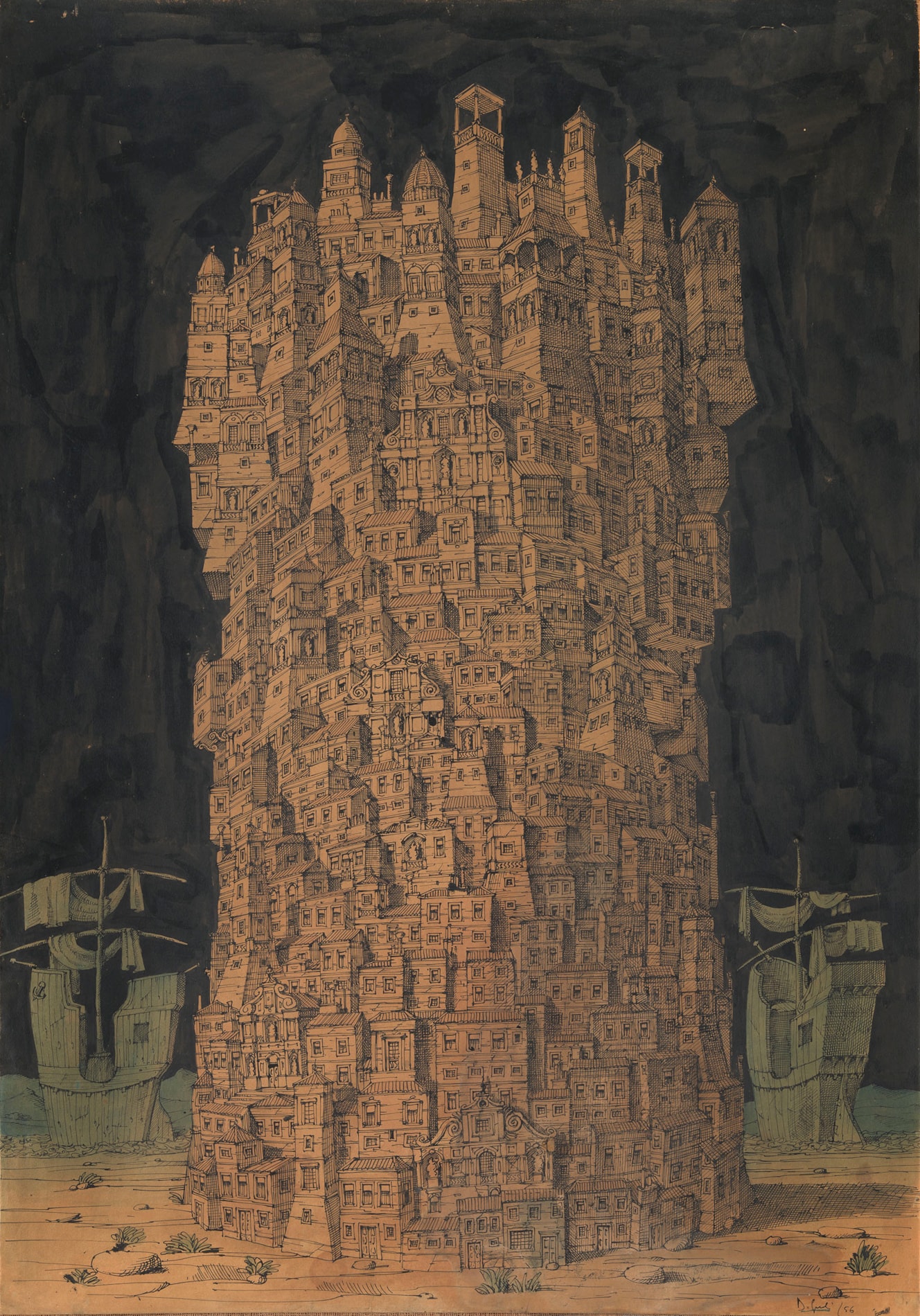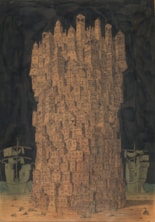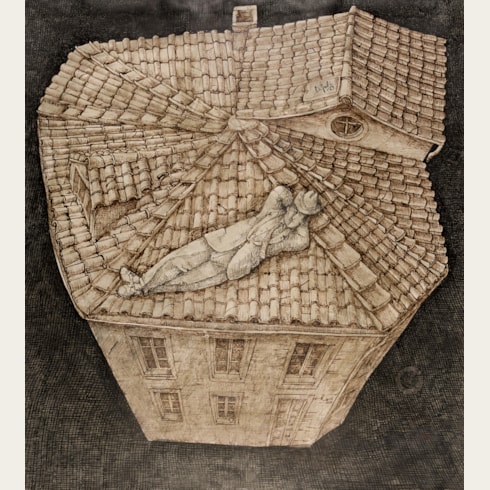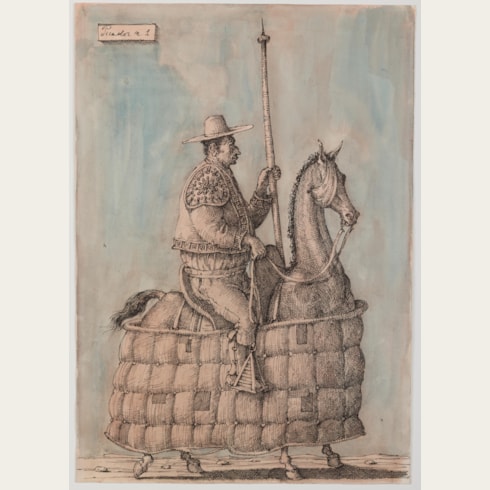Domenico GNOLI
(Rome 1933 - New York 1970)
Babylon
Sold
Pen and black ink and black wash, with watercolour, on buff paper laid down on canvas.
Signed and dated D. Gnoli / 56 at the lower right.
992 x 690 mm. (39 x 27 1/8 in.)
Signed and dated D. Gnoli / 56 at the lower right.
992 x 690 mm. (39 x 27 1/8 in.)
Drawn in 1956, this among the largest works on paper by Domenico Gnoli, and dates to the period when he had chosen to abandon working for the theatre, claiming that ‘it was distracting [him] from the essential’, in order to devote himself to drawing. A close stylistic comparison may be made with a much smaller ink drawing of an Imaginary City of 1956, sold at auction in 2006. Also comparable in technique and conception is an equally large pen and ink drawing, also of the same year as the present sheet, entitled The Ship of Emigrants (La nave degli emigranti), which was formerly in the collection of Frédéric Dard in Geneva, as well as a drawing entitled City of 1957, depicting an imaginary city resting on top of a table, which was in a private collection in Bath in 1985.
A Times review of an exhibition of drawings by Gnoli at the Arthur Jeffress Gallery in London in 1957, in which the present sheet may have been included, noted that ‘Mr. Gnoli’s drawings are complex, fantasticated, and full of busy goings-on of a mildly satirical absurdity – the general effect seems compounded of Babel and the Ship of Pools [sic]. Some of the most delightful are those in which he builds intricately crazy cities that tower up like insecure antheaps and bristle with activity...The success of imaginative excursions of this sort depends largely on the ability of the never-never land that has been created to sustain a measure of internal plausibility by which even the most extravagant oddities become, in context, the correct and acceptable thing. The world of Mr. Gnoli’s drawings may seem a largely synthetic and artificial one, but it does establish a sense of its own private logic by its exorbitant amount of quite rational detail. The impossible boats are all firmly built: one can count the nails. And though the tenement-blocks only stand up by the grace of architectural fiction, the construction of the innumerable doors, windows, stairways, and balconies of which they are composed appears eminently sound and reasonable.’
Another anonymous review of the same exhibition expressed the opinion that ‘Dominic Gnoli is an anachronism in draughtsmanship, a modern in paint. His drawings, more meticulous than Osbert Lancaster, more fantastic than Phiz, are full of ships and towers. The myriad Lillyputian figures of bullfighters, trippers, mariners and indeterminate crowds attendant have a sophisticated whimsy which would fit a period pantomime. Gnoli’s little people are cleverly stuffed stage props.’ A third reviewer simply chose to describe the artist as ‘addicted to towering and preposterious erections, whether pseudo-buildings or toppling nautical superstructures.’
The fantastic imagery, boundless wit and sheer technical virtuosity of Gnoli’s work continued to appeal to critics and collectors long after his untimely death. As Francesco Bonami has recently written, ‘Gnoli journeys across the cosmos and visits imaginary societies. He invented his own planet and traveled there like Antoine de Saint-Exupéry’s Little Prince. As an artist, Gnoli was truly an aristocrat, ruling his imagination like a kingdom. He observed his planet from both ends of the telescope: From one end he was able to see a faraway world, with many little characters on many different stages; from the other end, as if looking into a microscope, he was able to get very close, like a flea.’
A Times review of an exhibition of drawings by Gnoli at the Arthur Jeffress Gallery in London in 1957, in which the present sheet may have been included, noted that ‘Mr. Gnoli’s drawings are complex, fantasticated, and full of busy goings-on of a mildly satirical absurdity – the general effect seems compounded of Babel and the Ship of Pools [sic]. Some of the most delightful are those in which he builds intricately crazy cities that tower up like insecure antheaps and bristle with activity...The success of imaginative excursions of this sort depends largely on the ability of the never-never land that has been created to sustain a measure of internal plausibility by which even the most extravagant oddities become, in context, the correct and acceptable thing. The world of Mr. Gnoli’s drawings may seem a largely synthetic and artificial one, but it does establish a sense of its own private logic by its exorbitant amount of quite rational detail. The impossible boats are all firmly built: one can count the nails. And though the tenement-blocks only stand up by the grace of architectural fiction, the construction of the innumerable doors, windows, stairways, and balconies of which they are composed appears eminently sound and reasonable.’
Another anonymous review of the same exhibition expressed the opinion that ‘Dominic Gnoli is an anachronism in draughtsmanship, a modern in paint. His drawings, more meticulous than Osbert Lancaster, more fantastic than Phiz, are full of ships and towers. The myriad Lillyputian figures of bullfighters, trippers, mariners and indeterminate crowds attendant have a sophisticated whimsy which would fit a period pantomime. Gnoli’s little people are cleverly stuffed stage props.’ A third reviewer simply chose to describe the artist as ‘addicted to towering and preposterious erections, whether pseudo-buildings or toppling nautical superstructures.’
The fantastic imagery, boundless wit and sheer technical virtuosity of Gnoli’s work continued to appeal to critics and collectors long after his untimely death. As Francesco Bonami has recently written, ‘Gnoli journeys across the cosmos and visits imaginary societies. He invented his own planet and traveled there like Antoine de Saint-Exupéry’s Little Prince. As an artist, Gnoli was truly an aristocrat, ruling his imagination like a kingdom. He observed his planet from both ends of the telescope: From one end he was able to see a faraway world, with many little characters on many different stages; from the other end, as if looking into a microscope, he was able to get very close, like a flea.’
A precocious artist, Domenico Gnoli took private lessons in drawing and etching from the painter and printmaker Carlo Alberto Petrucci in Rome. He exhibited for the first time, aged just seventeen, at the Galleria La Cassapanca in Rome in 1950, and the following year his work was included in the exhibition Art Graphique Italien Contemporain at the Galerie Giroux in Brussels. After briefly studying theatre design at the Accademia di Belle Arti in Rome, Gnoli began working as a scenographer, producing designs for stage sets and costumes for a production of The Merchant of Venice at the Schauspielhaus in Zurich in 1953, while the following year he worked on designs for a staging of As You Like It at the Old Vic Theatre in London that opened in 1955. Despite the makings of a successful career as a scenographer, however, in 1956 Gnoli decided to give up theatrical work and to concentrate on drawing and painting. He lived between London, Paris and Rome before eventually settling in New York in 1956, where his friends included Leonard Bernstein, Henri Cartier-Bresson, Jerome Robbins and Diana Vreeland.
One-man shows of Gnoli’s drawings and prints were held in New York in 1956, London and Rome in 1957, Rome in 1958, New York in 1959, and London in 1960. He also worked as a book illustrator, writing and illustrating Orestes or the Art of Smiling, published in London in 1960, and two years later providing illustrations for the American writer Norman Juster’s Alberic the Wise and Other Journeys. He also received commissions for illustrations for magazines as diverse as Fortune, Life, Sports Illustrated, Holiday, Show, Horizon and several others, and in 1968 was awarded a gold medal by the Society of Illustrators in New York. Gnoli is perhaps best known today for his paintings executed from 1964 onwards; large canvases in which the artist almost obsessively concentrates his attention on isolated details of clothing, hair and objects.
Gnoli continued to have exhibitions of his work in Italy, France, Germany, England and America, where in 1969 his first solo exhibition of paintings was held at the Sidney Janis Gallery in New York. The year before, while that exhibition was being planned, Gnoli wrote to an American friend in New York: ‘I would hate you to think that I am just losing interest with all this, fooling myself with the idea that Janis will make a great painter out of me, and therefore I needn’t worry about drawings anymore. This would be mad, first because even if the show with him will do well it will only be a temporary success since the art scene is moving so fast that what is great today is shit tomorrow, second, I am, regardless of big money and glamour, a born illustrator, and will not renegade myself.’ Gnoli died in New York in April 1970, just over two weeks before his 37th birthday.
Works by Domenico Gnoli are today in the collections of, among others, the Stedelijk Museum in Amsterdam, the Baltimore Museum of Art, the Staatliche Museen in Berlin, the Museum of Fine Arts in Boston, the Musées Royaux des Beaux-Arts de Belgique in Brussels, the Museum Ludwig in Cologne, the Städel in Frankfurt, the Gemeentemuseum in The Hague, the Hamburger Kunsthalle in Hamburg, the Victoria and Albert Museum in London, the Museo Thyssen-Bornemisza in Madrid, the Museum of Modern Art and the Brooklyn Museum in New York, the Kunstnernes Hus in Oslo, the Philadelphia Museum of Art, the Galleria Nazionale d’Arte Moderna e Contemporanea in Rome, the Boijmans-van Beuningen Museum in Rotterdam, the Peggy Guggenheim Collection in Venice and the National Gallery of Art in Washington, D.C.
Provenance
Arthur Jeffress Gallery, London
Luise Rainer, London.
Exhibition
Probably London, Arthur Jeffress Gallery, Paintings and Drawings by Dominic Gnoli, 1957.









